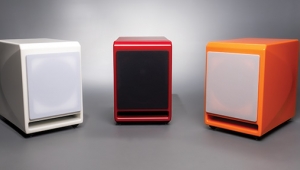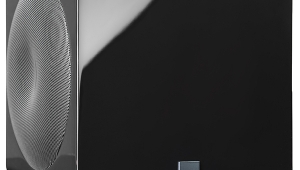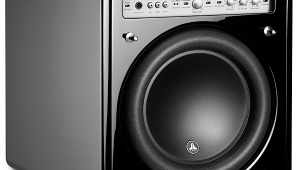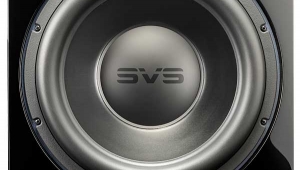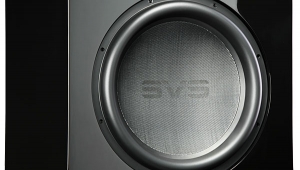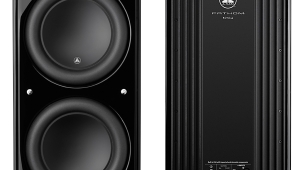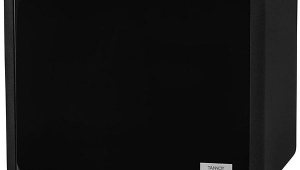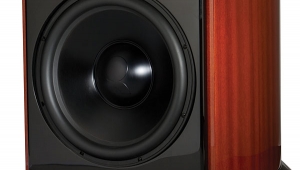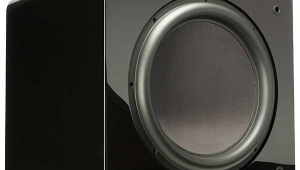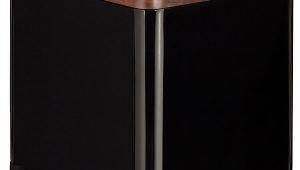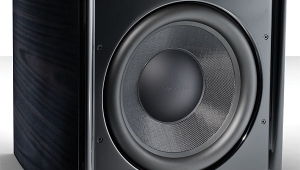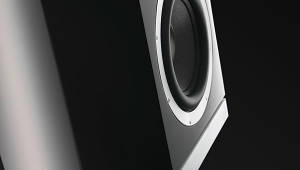| Columns Retired Columns & Blogs |
Paradigm Reference Servo-15 powered subwoofer Page 2
I moved the Paradigm sub around, first into corners and then to the center of the rear wall behind the main speakers, about 3' behind the Quad ESL-63's grilles and 10' from my listening chair. The review took place in my 5500-ft3 listening room: 25' long by 13' wide, with a 12' semi-cathedral ceiling and a rear area that opens into a large kitchen. Some subwoofers have overloaded ungracefully when played at high volumes into this large area. As a result, it's no surprise that, when I've asked a subwoofer to deliver 20-25Hz bass notes, it's the big ones—18" drivers with lots of amplifier power—that have done best. Still, I had high hopes for the compact Servo-15.
Footnote 3: D.B. Keele showed (in Audio, April 1998, p.70) that the Servo-15's limiter "put a cap on the maximum sound pressure level" and "allowed the subwoofer to generate 133dB SPL at 40Hz but only about 98dB at 20Hz."
I matched the satellite and main speakers to the Servo-15 by adjusting the X-30's controls from my listening chair. This required hauling out and connecting a huge, multicolored nest of cables and wires, including a yellow, industrial-grade 100' extension cord for the X-30's AC supply, 20' of heavy-duty AudioQuest Topaz interconnects to connect the X-30 to the Mark Levinson No.334 power amplifier, and another 15' run of Levinson interconnect cable to reach the Mark Levinson ML-7A preamplifier. Bass sources for this calibration included a steady 42Hz sinewave from the signal generator, or the repetitive bass drum on "Cosmo...Old Friend" from the Sneakers soundtrack CD (Columbia CK 53146). I also used Natalie Merchant's "One Fine Day," from the soundtrack album of the same name (Columbia CK 69716), to identify the best X-30 high-pass option. Merchant's voice sounded too thin using the 120Hz high-pass output jacks; the 50Hz jacks produced a more natural vocal timbre and gave the strongest stand-up bass sound in my listening room.
For all tests and listening, the Servo-15's rear-panel volume control was left at its middle position (-46dB). The X-30's front-panel controls ended up set as follows: Phase, 80 degrees or 90 degrees; Low-Pass, 100Hz or 120Hz; Bass Volume, -64 (B&W 805 Nautilus) or -59dB (Quad ESL-63). Minor bass-level adjustments were made for different CDs.
Clean sweep
I drove the X-30/Servo-15 with 60Hz-10Hz sinewaves from the Heathkit sinewave generator to check its bass extension and output level by ear, setting the level high enough to see considerable cone excursion. As noted by other reviewers (footnote 3). the Servo-15's output seemed to drop as the frequency descended. Sweeping the generator sinewave up from 10Hz, I sensed air pressure on my face and felt vibrations beginning at 17Hz, where the output was clean, with no sign of higher-order harmonics. Listening to the subwoofer play music by itself—using "Gnomus," from Jean Guillou's pipe-organ transcription of Mussorgsky's Pictures at an Exhibition (Dorian DOR-90117)—the output was ultra-clean, solid, tight, and free from rattles, static, or other spurious sounds. This is exactly the kind of performance I've come to expect from the best servo-controlled subwoofers.
The sound of music
First, the not-so-good news: While the Servo-15 reached all the deepest bass notes, it did not increase the punch or bass heft of the Quads. Each time I played the ponderous synthesizer rumblings of "Assault on Ryan's House" (from James Horner's Patriot Games soundtrack, RCA 66051-2), the Servo-15's output was just too precise to startle or frighten me. The well-recorded bass drum in Liberty Fanfare, on the National Symphonic Winds' Winds of War and Peace (Wilson Audiophile WCD-8823), seemed too polite over the Servo-15 in my room. Some compression was evident in the decay of the sound that followed each bass-drum whack, which, rather mechanically, intensified and shut off with the Servo-15 rather than gradually fading, as it did with the now-discontinued Velodyne FSR-18.
I tried—with limited success—to improve the Servo-15's cautious bass character in my large listening room by adjusting the X-30's controls. What made soundwave-generated tones sound perfect produced deep bass with excellent pitch but not enough punch. The X-30's phase and low-frequency cutoff controls could not increase the Quad's bass slam when they were augmented with the Servo-15. Try as I might, no phase or bass-level setting on the X-30 completely cured the Quad/Servo-15's tendency toward thin midbass—a suckout caused, I assume, by the Quad's backwave canceling more of the Servo-15's output than of the Velodyne's. Each time I thought I'd finally gotten the Servo-15's bass impact so it qualitatively matched the FSR-18's, I'd go back the next day and find I hadn't succeeded.
It tood a more expensive, 18" servo-controlled subwoofer, the Velodyne FSR-18, to overcome the challenges imposed by the room and the Quad dipoles. In level-matched comparisons, the FSR-18—which cost $1000 more than the Servo-15—bested it by having more bass slam, greater deep-bass extension, quicker bass-transient performance, and better ability to expand the Quad's dynamic range. This should be no surprise; the FSR-18's physical specifications differ substantially from the Servo-15's. The driver has 44% more surface area, its excursion is double that of the Servo-15's, its enclosure volume is 0.8ft3 greater, its amplifier is three times as powerful, and the sub itself has 20dB greater rated peak SPL output. These differences enabled the FSR-18/Quad combination to really shake my room, reproducing bass-drum whacks with powder-keg slam, while the Servo-15/Quad system had merely "excellent" bass.
Footnote 3: D.B. Keele showed (in Audio, April 1998, p.70) that the Servo-15's limiter "put a cap on the maximum sound pressure level" and "allowed the subwoofer to generate 133dB SPL at 40Hz but only about 98dB at 20Hz."
- Log in or register to post comments
